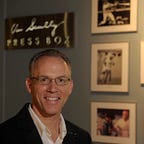Orel surgery: Dr. Frank Jobe’s other groundbreaking operation, 25 years ago
By Mark Langill
On April 26, 1990, Orel Hershiser was afforded a second chance not available to fellow Cy Young Award pitchers Don Drysdale and Sandy Koufax.
The 1988 World Series hero felt something was wrong with his shoulder early in the 1990 season. Hershiser later joked he was avoiding an MRI exam because the abbreviation stood for “maybe really injured.”
Koufax retired after the 1966 season due to arthritis in his elbow, despite winning 27 regular-season games and his third Cy Young Award. Koufax was only 30 when he walked away from baseball, explaining he’d rather quit “one year too early than one year too late.” Drysdale set a MLB record with six consecutive shutouts during his 1968 streak of 58 2/3 consecutive scoreless innings. But a torn rotator cuff during the 1969 season ended Drysdale’s career at age 33.
Hershiser surpassed Drysdale’s streak with 59 scoreless innings to end the 1988 regular season, the prelude to winning MVP awards in the Dodgers’ postseason wins over the New York Mets in the NLCS and the Oakland Athletics in the World Series. Between 1987 and 1989, Hershiser averaged 263 innings per season and completed 33 of 103 starts.
At age 31 in 1990, the workload finally caught up with Hershiser. After allowing five runs in 6 1/3 innings on April 25 against the Cardinals at Dodger Stadium, Hershiser was diagnosed with damage to his rotator cuff and anterior labrum.
Team physician Dr. Frank Jobe proposed a surgery more radical than the experimental ligament-transplant surgery used in 1974 on Dodger left-hander Tommy John. Jobe had performed labrum surgery on NFL quarterback Jim McMahon and PGA golfer Jerry Pate. But never a Major League pitcher. Jobe reconstructed Hershiser’s anterior capsule and tightened the ligaments in his right shoulder.
“His reputation preceded his advice on the surgery,” Hershiser said of Jobe, who passed away in 2014. “He probably prescribed the most radical thing that could’ve happened to me, and I didn’t second-guess at all. I didn’t want a second opinion. I didn’t need anybody else telling me what was wrong with me and how to fix it.”
John pitched until age 46 in 1989, leaving Jobe to wonder what would’ve happened had some of the game’s early pitching stars had access to modern medical technology. Dodger rookie left-hander Karl Spooner pitched two shutouts at the end of the 1954 season with a combined 27 strikeouts. But Spooner hurt his shoulder the following spring, likely from throwing in front of photographers before properly warming up.
“If we knew then that we know now, we probably could’ve saved the careers of such athletes as Joe Wood, Dizzy Dean and Karl Spooner,” Jobe said in a 2007 interview. “In the case of Spooner, he probably had a rotator cuff tear or a torn labrum. Back in those days, the thought was if you were being bothered by a sore joint, it was being seeded by an infection from some other part of the body. And the most common place was abscessed teeth. So he was sent to a dentist and had all of his teeth pulled. So now you have a pitcher with no teeth and still a sore shoulder. So he was never a pitcher again.”
After a long and grueling rehabilitation period, Hershiser returned to the Majors in June 1991 and continued to pitch with the Dodgers, Indians, Giants and Mets until 2000. Like Tommy John, Hershiser would win more games after his surgery than before. Hershiser won 105 games after the shoulder procedure and posted a 204–150 record overall.
Before the 1990 surgery, Jobe showed Hershiser the tools he would use for the operation. Hershiser joked that if the surgery was a success, he’d have the instruments bronzed. Hershiser went one step further with the plans after making his comeback.
The pitcher ordered a set of instruments from the manufacturer and had them gold plated. He then hired a trophy maker to arrange them on a granite base in the shape of a baseball holder, which he placed the game ball from his 100th career victory — his first after the surgery.
The inscription on the trophy read:
Victory #100
June 9, 1991
Made Possible By The Skilled Hands of
FRANK JOBE
With Gratitude
Orel Hershiser, Los Angeles Dodgers
Hershiser gave Jobe the trophy at a dinner he hosted for the doctors and trainers who aided in his comeback. Jobe had the trophy displayed in his office.
“Every time he won a game, I felt crying,” Jobe said.
